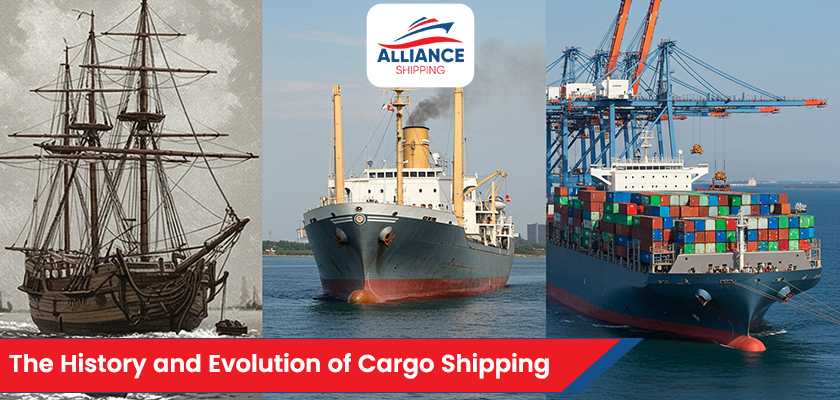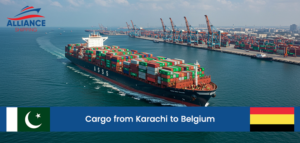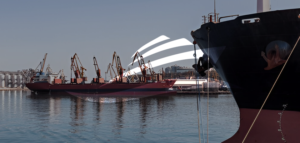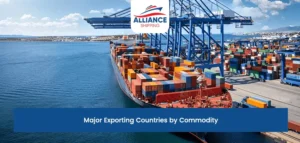This soft clicking of my typing fingers sounds like a beat of movement, and in my mind, the characters are running across the screen just as goods run across oceans. Reading the history of cargo shipping is not all about the ships and the containers but about human beings, the idea, and the need to be connected. All its phases in history are possible only due to human creativity: transporting grain in wooden barrels to assembling containers in the perfect stacks, and traveling around the globe.
It is important to understand the history of cargo shipping not only because it is the trade, but it is also the invisible connection of countries, cultures, and life. Every time you sip imported coffee, wear clothes stitched overseas, or use a phone built with parts from many regions, you are holding a piece of this history in your hands. Let’s explore where it all started, how it grew, and where it might be heading.
Early Beginnings: Barrels, Sails, and Risky Journeys
The history of cargo shipping could be traced back as far as thousands of years ago, when things and items used to be transported on simple wooden vessels driven by sails. The ancient merchants imported spices, grains, fabrics, and tools across rivers and seas, and the items were usually piled up in barrels, sacks, or wooden crates. Workers in the dock were not treated well: it was a lot of heavy work, with repetitive loading and unloading by hand; this was dirty work and dangerous too. In those days, ships pitched and tossed with the waves, and without adequate storage, cargo frequently turned bad and went to the bottom.
Trade thrived in spite of the risks. Ancient Egyptians used to transport trade goods by the Nile, whereas Phoenicians became known as the traders across the Mediterranean. The Romans later constructed tough merchant vessels which transported wine, olive oil, and grain throughout their empire. Even then, people had understood that shipping by sea was faster and less costly compared to the means of long-distance travel by roads.
As we type these words, we can picture how every single crate packed on the early vessels would have been not only packed with goods, but filled with the hope that their markets to which they were sending their goods would accept them, as well as having sailors return to them with some new commodity to market themselves. These poor origins were the start of the largest system of transportation in the history of man.
The Container Revolution: A Simple Box That Changed Everything
The most notable directional shift in the history of shipping goods occurred in the mid-20th century, when there was one rather humble-looking invention, the container. Previously, the offloading of ships was inconveniently long. Improvements of any sort had to be carried out piece by piece by workers. It might be days, it might be weeks, before a single ship is loaded. This was frustrating to both traders and workers.
Along came Malcolm McLean, a trucking entrepreneur based in the United States. In 1956, he proposed the use of cargo containers to put freight inside uniform boxes of large size, which could be hoisted on ships. In its inaugural trip between New Jersey and Texas, his ship, the Ideal X, transported 58 containers. All of a sudden, goods could be transported without even unpacking them.
Coupled with that, standardized containers were introduced shortly afterward, and the 20-foot and 40-foot containers became universally accepted. This was not just an upgrade but a mindset change of course New terminals conjoined with cranes, warehouses, and processes. Cargoes handling was less costly, faster, and safer.
When we visualize this experience, it is like changing a typewriter to a new computer. The work, however, the writing, remains the same, but efficiency, ease, and potential broaden it beyond imagination. The container box might not be very fancy, but it revolutionized international trade.
Expanding Ports and Global Trade
The history of cargo shipping does not take into account only the ships; it is about the ports. Since containers became the standard, other ports of the world had to change. Wooden docks used by sacks and barrels were changed to large terminals with huge cranes, an automation system, and structured storage areas.
The ports of Rotterdam, Singapore, and Los Angeles are examples that swelled into international trade centers in the 1970s and 1980s. Ships got bigger, and they ship thousands of containers simultaneously on a single trip. They were nearly beyond belief, floating cities as big as they could imagine, big ships full of merchandise. This increased the cost of shipping by a vast margin, which meant the potential of getting any goods available in any region to be procured cheaply. Coffee could be shipped across ocean waters efficiently to Brazil, electronics products produced in Japan, and cloth produced in Bangladesh could all be sent to the market efficiently.
It was not only the world trade that was involved. Ports were also local catalysts, supporting employment at the dockside, at the customs, and on the road as well as on the planning surfaces. Port towns enjoyed increased growth in terms of road infrastructure and the development of stronger economies.
Framing the servers and networking, whichever part of the globe there is, through typing in a laptop brings connectivity moments in the present day. Ports, in their turn, are that physical connectivity point. They are not merely box movers, but they do change lives and opportunities across continents.
Modern Shifts: Technology and Sustainability in Cargo Shipping
The history of cargo shipping is still in progress. In the current world, shipping efficiency is defined not only by efficiency but also by technology and eco-responsibility. Current ships are floating wonders, with navigation tools, automated cranes, and real-time monitoring of cargo. Now containers have sensors that inform the location, temperature, and security status. This brings about rest to the businesses as they are able to know where their goods are at a given time.
Meanwhile, environmental issues and awareness are causing the industry to change. Cargo ships contribute a sizeable amount to world emissions and efforts by port and shipping companies to invest in cleaner propellant, hybrid motors, or even experimental applications such as wind-powered sails, or support of solar power. The trend in shipping is not just related to speed and capacity- it is also about being smarter and greener.
There are still problems. Shipboard congestion, weather at sea, and losses of containers remind us that even the most advanced systems are fallible. Shipping is a human sector and one in which people work around the clock to keep everything moving.
Final Thoughts: Why the History of Cargo Shipping Matters
When we consider the history of cargo shipping, one fact cannot evade our attention: it is all about human problem-solving. All the innovations were made out of a simple necessity of helping people and goods connect on a new level. This need led to massive barrel stacking on wooden vessels and all the way to millions of containers transported on smart ports.
Shipping plays a key role in the current globalization. Approximately 90 percent of global trade moves over the water in a calm spirit pouring life into the economies and everyday life. The product that you order, the tools that you are using, have most likely been through a long process.
When you look at a shipping container on a truck or a cargo ship on a distant horizon, don’t think of that as only steel and goods. It is its past history, its development, and the beating heart of commerce that make the world go around.























